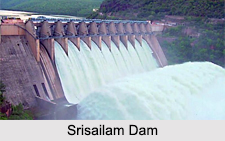 Dams in Andhra Pradesh stand on various Indian rivers and serve the purposes of irrigation, generation of hydroelectricity, thermal power generation and supplying drinking water to all the districts of the state. They help in regulating excess water which goes on to check a natural calamity called floods. These popular spots also promote tourism in Andhra Pradesh.
Dams in Andhra Pradesh stand on various Indian rivers and serve the purposes of irrigation, generation of hydroelectricity, thermal power generation and supplying drinking water to all the districts of the state. They help in regulating excess water which goes on to check a natural calamity called floods. These popular spots also promote tourism in Andhra Pradesh.
Somasila Dam
Somasila Dam stands on the Pennar River. This dam has been constructed in a small town by the name of Somasila in Nellore district. The project was constructed during the tenure of Chief Minister, N.T. Rama Rao. This project has become very vital as far as agriculture in the state is concerned. It supplies water to several agricultural fields in different villages in Andhra Pradesh.
Srisailam Dam
Srisailam Dam stands across Krishna River. It is situated on the border between Mahabubnagar district in Telangana and Kurnool district in Andhra Pradesh. The dam has been constructed in a deep gorge in the Nallamala Hills and has been placed about 300 meters above sea level. It is one of the major dam related projects of Andhra Pradesh. It is also one of the 12 largest hydroelectric projects in India. Srisailam Dam provides water for irrigation to about 800 square kilometers of land in Kurnool district and Cuddapah district.
Nagarjuna Sagar Dam
Nagarjuna Sagar Dam has been constructed across Krishna River. The dam is located in Nalgonda District in Telangana and Guntur District in Andhra Pradesh. It was opened in the year 1967. The dam serves the purpose of hydroelectricity generation and providing irrigation water.
Kalyani Dam
Kalyani Dam has been constructed across Swarnamukhi River. This gravity dam is located in the Indian city of Tirupati in Chittoor district. Kalyani Dam was built in 1977. The dam has a storage capacity of about 25 million cubic meters between hills which are part of the Seshachalam Hill ranges. This dam serves the purpose of providing water to the city of Tirupati and its catchment areas.
Jalaput Dam
Jalaput Dam has been constructed on Machkund River, which is a tributary of Godavari River. This hydroelectric dam was opened in the year 2000 and is operated by the Indian states of Andhra Pradesh and Odisha.
Mylavaram Dam
Mylavaram Dam is located across the Pennar River in Kadapa district near Mylavaram. It is a medium irrigation project and a reservoir with a gross storage capacity of about 9.96 one thousand million cubic feet.
Other Dams in Andhra Pradesh
Some of the other Dams in Andhra Pradesh are Mid Penna Reservoir Dam, Akkapalem Dam, Alaganoor Dam, Ananthasagarm Dam and Andhra Dam.















